2014 FORD F150 warning
[x] Cancel search: warningPage 10 of 41
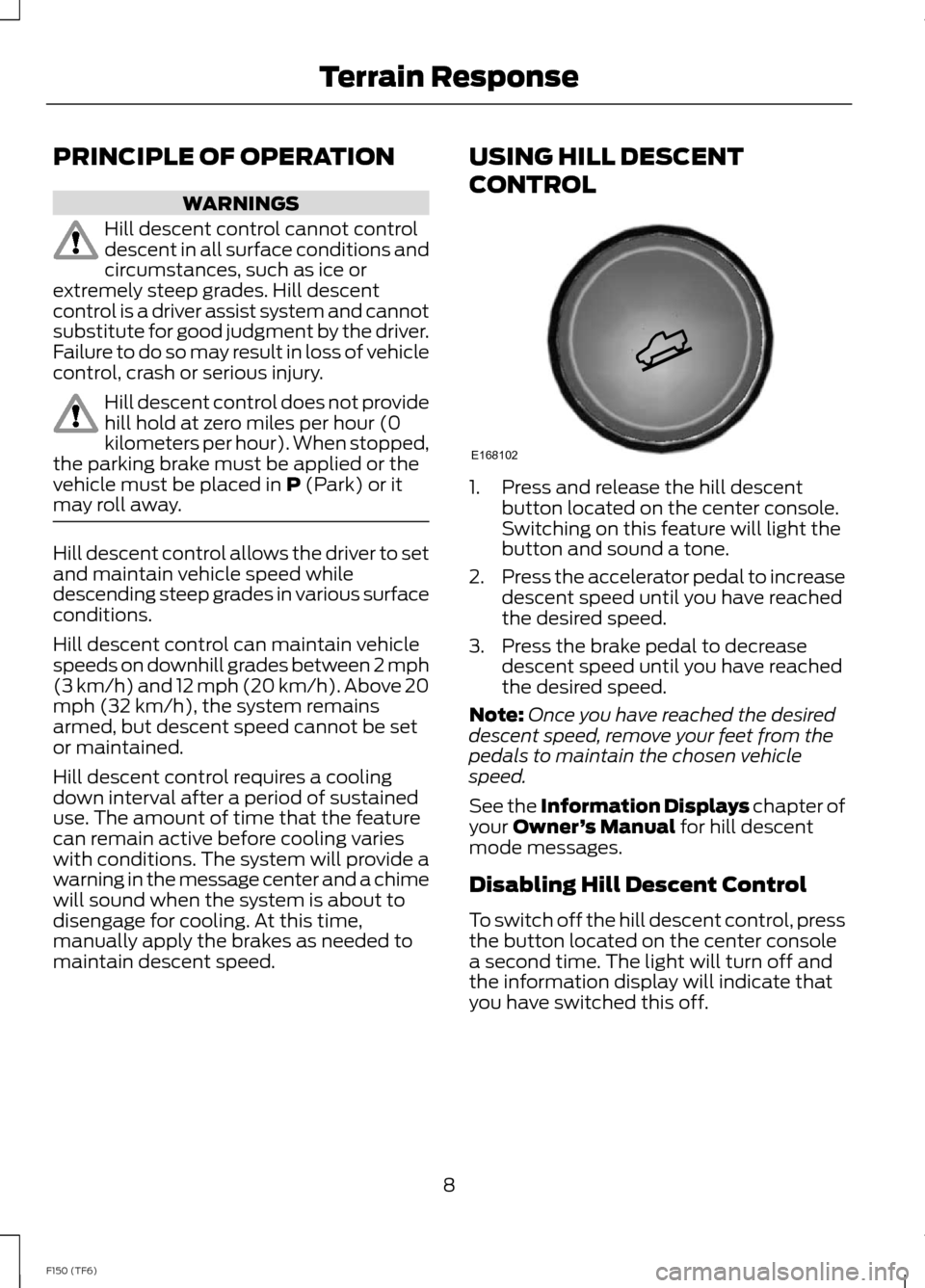
PRINCIPLE OF OPERATION
WARNINGS
Hill descent control cannot controldescent in all surface conditions andcircumstances, such as ice orextremely steep grades. Hill descentcontrol is a driver assist system and cannotsubstitute for good judgment by the driver.Failure to do so may result in loss of vehiclecontrol, crash or serious injury.
Hill descent control does not providehill hold at zero miles per hour (0kilometers per hour). When stopped,the parking brake must be applied or thevehicle must be placed in P (Park) or itmay roll away.
Hill descent control allows the driver to setand maintain vehicle speed whiledescending steep grades in various surfaceconditions.
Hill descent control can maintain vehiclespeeds on downhill grades between 2 mph(3 km/h) and 12 mph (20 km/h). Above 20mph (32 km/h), the system remainsarmed, but descent speed cannot be setor maintained.
Hill descent control requires a coolingdown interval after a period of sustaineduse. The amount of time that the featurecan remain active before cooling varieswith conditions. The system will provide awarning in the message center and a chimewill sound when the system is about todisengage for cooling. At this time,manually apply the brakes as needed tomaintain descent speed.
USING HILL DESCENT
CONTROL
1.Press and release the hill descentbutton located on the center console.Switching on this feature will light thebutton and sound a tone.
2.Press the accelerator pedal to increasedescent speed until you have reachedthe desired speed.
3.Press the brake pedal to decreasedescent speed until you have reachedthe desired speed.
Note:Once you have reached the desireddescent speed, remove your feet from thepedals to maintain the chosen vehiclespeed.
See the Information Displays chapter ofyour Owner’s Manual for hill descentmode messages.
Disabling Hill Descent Control
To switch off the hill descent control, pressthe button located on the center consolea second time. The light will turn off andthe information display will indicate thatyou have switched this off.
8F150 (TF6)Terrain ResponseE168102
Page 11 of 41
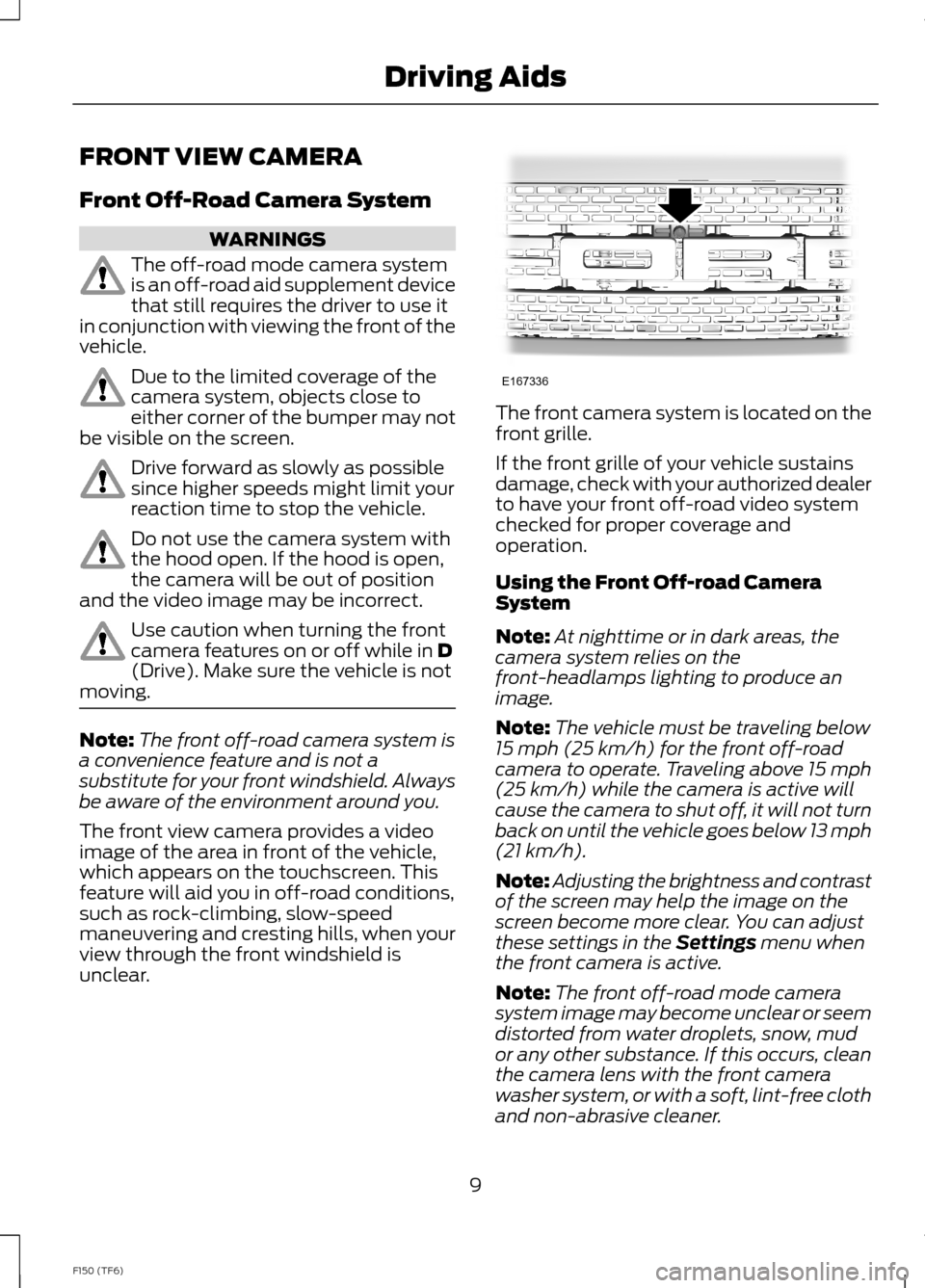
FRONT VIEW CAMERA
Front Off-Road Camera System
WARNINGS
The off-road mode camera systemis an off-road aid supplement devicethat still requires the driver to use itin conjunction with viewing the front of thevehicle.
Due to the limited coverage of thecamera system, objects close toeither corner of the bumper may notbe visible on the screen.
Drive forward as slowly as possiblesince higher speeds might limit yourreaction time to stop the vehicle.
Do not use the camera system withthe hood open. If the hood is open,the camera will be out of positionand the video image may be incorrect.
Use caution when turning the frontcamera features on or off while in D(Drive). Make sure the vehicle is notmoving.
Note:The front off-road camera system isa convenience feature and is not asubstitute for your front windshield. Alwaysbe aware of the environment around you.
The front view camera provides a videoimage of the area in front of the vehicle,which appears on the touchscreen. Thisfeature will aid you in off-road conditions,such as rock-climbing, slow-speedmaneuvering and cresting hills, when yourview through the front windshield isunclear.
The front camera system is located on thefront grille.
If the front grille of your vehicle sustainsdamage, check with your authorized dealerto have your front off-road video systemchecked for proper coverage andoperation.
Using the Front Off-road CameraSystem
Note:At nighttime or in dark areas, thecamera system relies on thefront-headlamps lighting to produce animage.
Note:The vehicle must be traveling below15 mph (25 km/h) for the front off-roadcamera to operate. Traveling above 15 mph(25 km/h) while the camera is active willcause the camera to shut off, it will not turnback on until the vehicle goes below 13 mph(21 km/h).
Note:Adjusting the brightness and contrastof the screen may help the image on thescreen become more clear. You can adjustthese settings in the Settings menu whenthe front camera is active.
Note:The front off-road mode camerasystem image may become unclear or seemdistorted from water droplets, snow, mudor any other substance. If this occurs, cleanthe camera lens with the front camerawasher system, or with a soft, lint-free clothand non-abrasive cleaner.
9F150 (TF6)Driving AidsE167336
Page 16 of 41

WARNINGS
Do not disconnect the battery duringrecreational towing. Doing so willprevent the transfer case fromshifting properly and may cause the vehicleto roll even if the transmission is in P(Park).
Shifting the transfer case to itsneutral position for recreationaltowing may cause the vehicle to beable to roll even if the transmission is in P(Park). The driver or others could beinjured. Make sure the foot brake isdepressed and the vehicle is in a secureand safe position while the transfer caseis being shifted to its neutral position.
Failing to put the transfer case in itsneutral position will damage vehiclecomponents.
Note:You can check four-wheel-downtowing status at any time by opening thedriver's door or turning the ignition to theaccessory or on position and verifying theNEUTRAL TOW ENABLED messagedisplays in the cluster.
To exit four-wheel-down towing and returnthe transfer case to its 2H position:
1.With your vehicle still properly securedto the tow vehicle, press and hold thebrake pedal.
2.Turn the ignition to the on position. Donot start the engine.
3.Shift the transmission out of N and intoany gear.
4.Release the brake pedal.
Note:If completed successfully, theinstrument cluster displays 4X2, andNEUTRAL TOW DISABLED.
Note:If the indicator light and message donot display, you must perform the procedureagain from the beginning.
Note:You may hear an audible noise as thetransfer case shifts out of its neutralposition. This is normal.
5.Apply the parking brake, and thendisconnect the vehicle from the towvehicle.
6.Release the parking brake, start theengine, and shift the transmission toposition D to make sure the transfercase is out of position N.
7.If the transfer case does notsuccessfully shift out of position N, setthe parking brake until you can haveyour vehicle serviced.
14F150 (TF6)Towing
Page 17 of 41
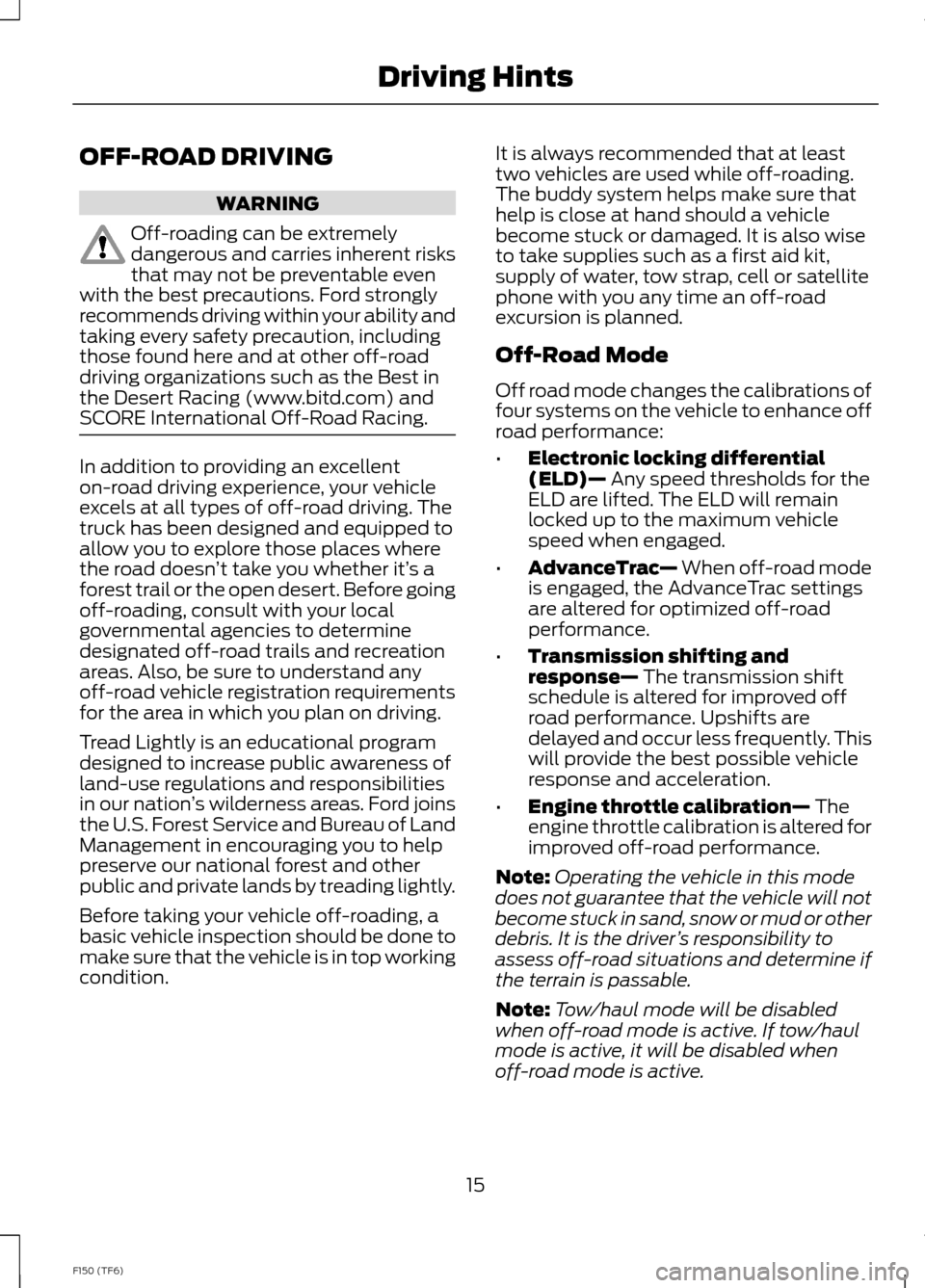
OFF-ROAD DRIVING
WARNING
Off-roading can be extremelydangerous and carries inherent risksthat may not be preventable evenwith the best precautions. Ford stronglyrecommends driving within your ability andtaking every safety precaution, includingthose found here and at other off-roaddriving organizations such as the Best inthe Desert Racing (www.bitd.com) andSCORE International Off-Road Racing.
In addition to providing an excellenton-road driving experience, your vehicleexcels at all types of off-road driving. Thetruck has been designed and equipped toallow you to explore those places wherethe road doesn’t take you whether it’s aforest trail or the open desert. Before goingoff-roading, consult with your localgovernmental agencies to determinedesignated off-road trails and recreationareas. Also, be sure to understand anyoff-road vehicle registration requirementsfor the area in which you plan on driving.
Tread Lightly is an educational programdesigned to increase public awareness ofland-use regulations and responsibilitiesin our nation’s wilderness areas. Ford joinsthe U.S. Forest Service and Bureau of LandManagement in encouraging you to helppreserve our national forest and otherpublic and private lands by treading lightly.
Before taking your vehicle off-roading, abasic vehicle inspection should be done tomake sure that the vehicle is in top workingcondition.
It is always recommended that at leasttwo vehicles are used while off-roading.The buddy system helps make sure thathelp is close at hand should a vehiclebecome stuck or damaged. It is also wiseto take supplies such as a first aid kit,supply of water, tow strap, cell or satellitephone with you any time an off-roadexcursion is planned.
Off-Road Mode
Off road mode changes the calibrations offour systems on the vehicle to enhance offroad performance:
•Electronic locking differential(ELD)— Any speed thresholds for theELD are lifted. The ELD will remainlocked up to the maximum vehiclespeed when engaged.
•AdvanceTrac— When off-road modeis engaged, the AdvanceTrac settingsare altered for optimized off-roadperformance.
•Transmission shifting andresponse— The transmission shiftschedule is altered for improved offroad performance. Upshifts aredelayed and occur less frequently. Thiswill provide the best possible vehicleresponse and acceleration.
•Engine throttle calibration— Theengine throttle calibration is altered forimproved off-road performance.
Note:Operating the vehicle in this modedoes not guarantee that the vehicle will notbecome stuck in sand, snow or mud or otherdebris. It is the driver’s responsibility toassess off-road situations and determine ifthe terrain is passable.
Note:Tow/haul mode will be disabledwhen off-road mode is active. If tow/haulmode is active, it will be disabled whenoff-road mode is active.
15F150 (TF6)Driving Hints
Page 18 of 41

Enabling off-road mode
WARNING
Off-road mode is specificallycalibrated for off-road drivingconditions and should never be usedon pavement.
To enter off-road mode the followingconditions must be met:
•The vehicle must be traveling less than5 mph (8 km/h).
•Your foot must be off of theaccelerator pedal.
Note:If any of the conditions are not met,the information display screen will displaythe appropriate messages to guide the driverthrough the proper operating procedures.
To activate off-road mode press thebutton located on the center console. Achime will sound and a message willappear indicating that it is activated.
Disabling off-road mode
To disable off-road mode once it is activepress the off-road mode button a secondtime. A chime will sound and a messagewill appear indicating that it is deactivated.
AdvanceTrac Modes
During off-road mode the AdvanceTracsystem provides the vehicle withalternative AdvanceTrac calibrations,which improve off-road performance.
Off-road AdvanceTrac calibrations areenabled for 2H and 4H. When theAdvanceTrac button is pressed onceAdvanceTrac Sport will engage. In thismode the vehicle will have ABS, tractioncontrol and yaw control settingsspecifically calibrated for off-roadcondition. When the AdvanceTrac buttonis pressed and held AdvanceTrac willbecome disabled. In this mode onlyoff-road calibrated ABS remains active.Also, when off-road mode is not engaged,the AdvanceTrac disabled mode will notrevert to AdvanceTrac Sport mode abovethe speed threshold in place.
To switch between AdvanceTrac modeswith off-road mode active, press theAdvanceTrac button located on theinstrument panel.
16F150 (TF6)Driving HintsE167335 E166706
Page 22 of 41

Before operating your vehicle at higherthan normal speeds:
•Make sure your tires are at the correcttire pressure. See Tire Care (page 26).
•Inspect wheels and tires for wear anddamage. Replace any damaged wheelsor tires.
•Never operate the vehicle at higherthan normal speeds when loaded withpassengers/cargo.
Driving in Mud
•Deep mud should be approached withcaution especially if you are driving inan unfamiliar area.
•If possible, test the depth of a mud holebefore entering with the vehicle.
•Keep in mind that obstacles and deepruts may be hidden beneath thesurface of the mud.
•Proceed in a steady, controlled mannerthrough deep mud while maintainingmomentum.
•If momentum is lost and you feel thevehicle becoming stuck, turning thesteering wheel back and forth (sawingthe wheel) quarter turn in eachdirection may give the traction youneed to clear the muddy area.
•In higher speed areas with shallowmud, directional control will be reducedin the muddy area much like on snowor ice. When approaching such an area,be sure to slow to a speed whichallows you to maneuver as required bythe conditions.
Driving in Sand
WARNING
Tires must be returned to normalrecommended tire pressures beforedriving on pavement or hardsurfaces. Failure to properly maintain yourtire pressure could increase the risk of tirefailure, loss of control, vehicle rollover andpersonal injury.
Soft sand and dunes present a very uniquedriving challenge. Before going on such adrive, some research is advised regardingproven techniques and pitfalls inherent indriving in deep sand.
Some general points to consider:
•It is very difficult and in many casesimpossible to navigate deep sand withtire pressures which are appropriate foron-road driving. If you decide to airdown your tires, be advised that the tirepressure monitoring light willilluminate. The tires must be returnedto normal recommended tire pressuresbefore driving on pavement or hardsurfaces.
•Lower tire pressures are more likely tocause a debeading of the tire duringcornering. Avoid sharp or abrupt turnswhen you have extremely low tirepressures.
•To help prevent becoming stuck indeep sand, avoid spinning the tires ormaking abrupt maneuvers. Proceed ina controlled manner while maintainingvehicle momentum.
•Avoid stopping or parking on inclinesas this makes it more difficult toresume driving.
20F150 (TF6)Driving Hints
Page 23 of 41
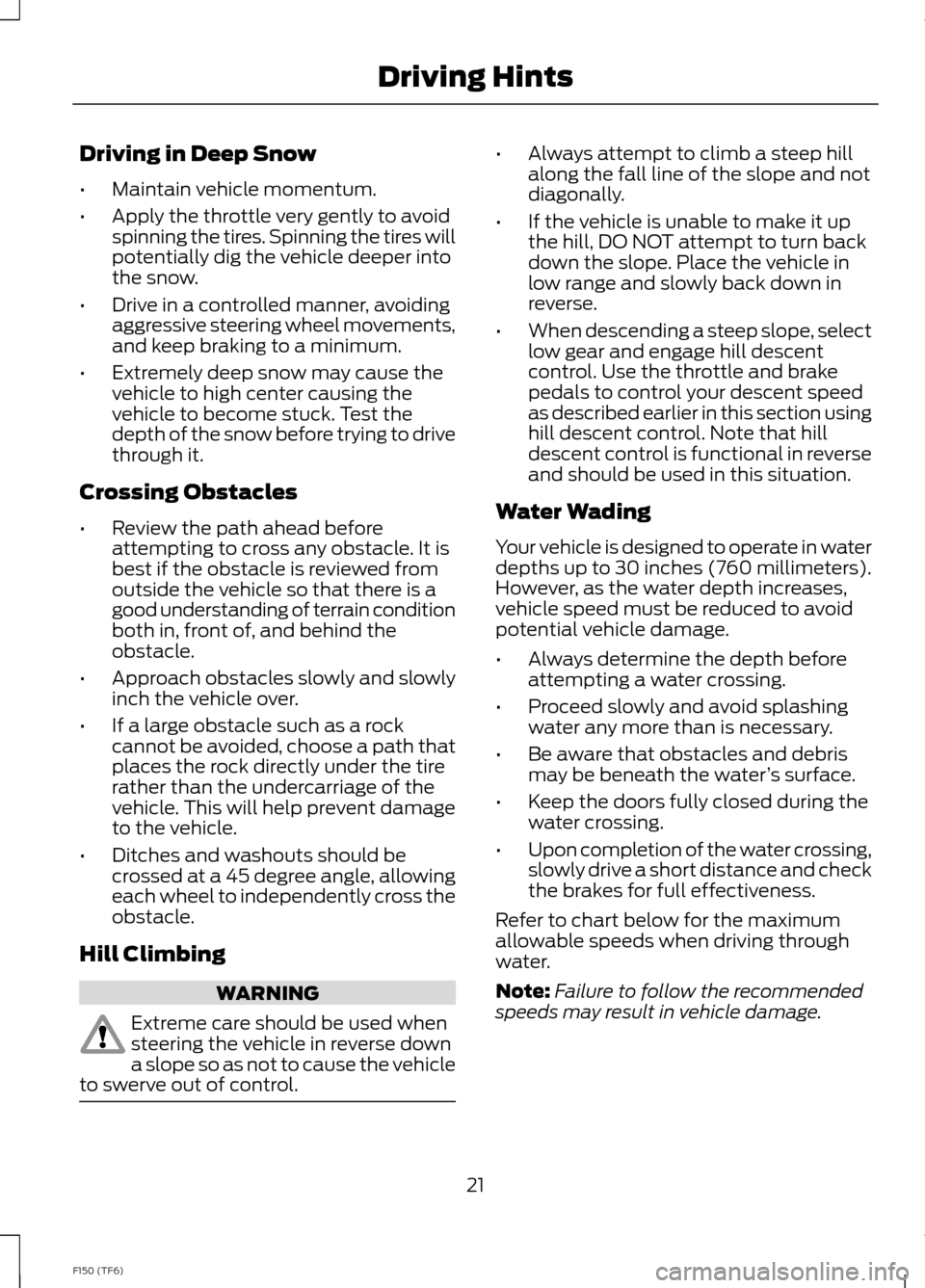
Driving in Deep Snow
•Maintain vehicle momentum.
•Apply the throttle very gently to avoidspinning the tires. Spinning the tires willpotentially dig the vehicle deeper intothe snow.
•Drive in a controlled manner, avoidingaggressive steering wheel movements,and keep braking to a minimum.
•Extremely deep snow may cause thevehicle to high center causing thevehicle to become stuck. Test thedepth of the snow before trying to drivethrough it.
Crossing Obstacles
•Review the path ahead beforeattempting to cross any obstacle. It isbest if the obstacle is reviewed fromoutside the vehicle so that there is agood understanding of terrain conditionboth in, front of, and behind theobstacle.
•Approach obstacles slowly and slowlyinch the vehicle over.
•If a large obstacle such as a rockcannot be avoided, choose a path thatplaces the rock directly under the tirerather than the undercarriage of thevehicle. This will help prevent damageto the vehicle.
•Ditches and washouts should becrossed at a 45 degree angle, allowingeach wheel to independently cross theobstacle.
Hill Climbing
WARNING
Extreme care should be used whensteering the vehicle in reverse downa slope so as not to cause the vehicleto swerve out of control.
•Always attempt to climb a steep hillalong the fall line of the slope and notdiagonally.
•If the vehicle is unable to make it upthe hill, DO NOT attempt to turn backdown the slope. Place the vehicle inlow range and slowly back down inreverse.
•When descending a steep slope, selectlow gear and engage hill descentcontrol. Use the throttle and brakepedals to control your descent speedas described earlier in this section usinghill descent control. Note that hilldescent control is functional in reverseand should be used in this situation.
Water Wading
Your vehicle is designed to operate in waterdepths up to 30 inches (760 millimeters).However, as the water depth increases,vehicle speed must be reduced to avoidpotential vehicle damage.
•Always determine the depth beforeattempting a water crossing.
•Proceed slowly and avoid splashingwater any more than is necessary.
•Be aware that obstacles and debrismay be beneath the water’s surface.
•Keep the doors fully closed during thewater crossing.
•Upon completion of the water crossing,slowly drive a short distance and checkthe brakes for full effectiveness.
Refer to chart below for the maximumallowable speeds when driving throughwater.
Note:Failure to follow the recommendedspeeds may result in vehicle damage.
21F150 (TF6)Driving Hints
Page 28 of 41
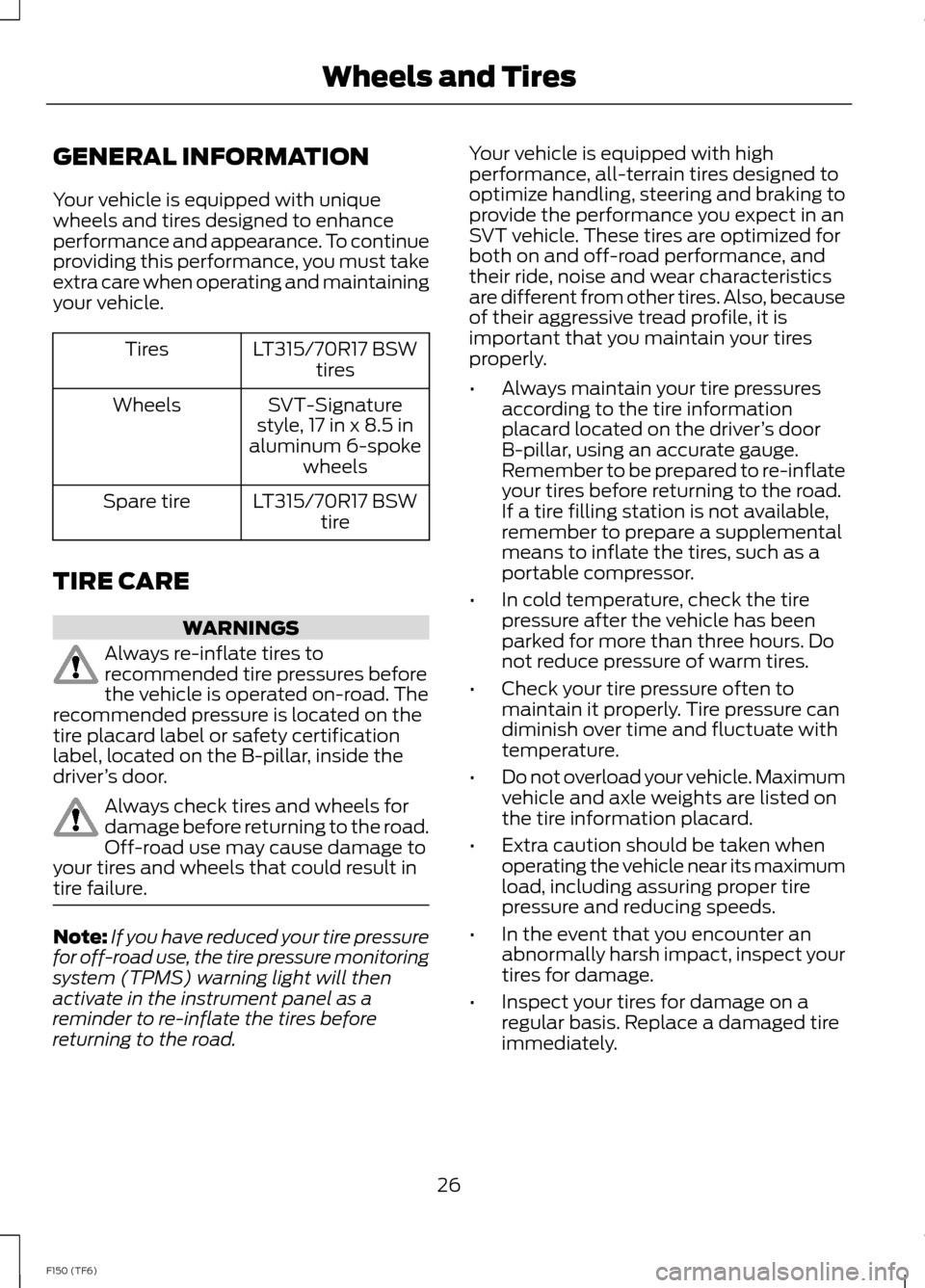
GENERAL INFORMATION
Your vehicle is equipped with uniquewheels and tires designed to enhanceperformance and appearance. To continueproviding this performance, you must takeextra care when operating and maintainingyour vehicle.
LT315/70R17 BSWtiresTires
SVT-Signaturestyle, 17 in x 8.5 inaluminum 6-spokewheels
Wheels
LT315/70R17 BSWtireSpare tire
TIRE CARE
WARNINGS
Always re-inflate tires torecommended tire pressures beforethe vehicle is operated on-road. Therecommended pressure is located on thetire placard label or safety certificationlabel, located on the B-pillar, inside thedriver’s door.
Always check tires and wheels fordamage before returning to the road.Off-road use may cause damage toyour tires and wheels that could result intire failure.
Note:If you have reduced your tire pressurefor off-road use, the tire pressure monitoringsystem (TPMS) warning light will thenactivate in the instrument panel as areminder to re-inflate the tires beforereturning to the road.
Your vehicle is equipped with highperformance, all-terrain tires designed tooptimize handling, steering and braking toprovide the performance you expect in anSVT vehicle. These tires are optimized forboth on and off-road performance, andtheir ride, noise and wear characteristicsare different from other tires. Also, becauseof their aggressive tread profile, it isimportant that you maintain your tiresproperly.
•Always maintain your tire pressuresaccording to the tire informationplacard located on the driver’s doorB-pillar, using an accurate gauge.Remember to be prepared to re-inflateyour tires before returning to the road.If a tire filling station is not available,remember to prepare a supplementalmeans to inflate the tires, such as aportable compressor.
•In cold temperature, check the tirepressure after the vehicle has beenparked for more than three hours. Donot reduce pressure of warm tires.
•Check your tire pressure often tomaintain it properly. Tire pressure candiminish over time and fluctuate withtemperature.
•Do not overload your vehicle. Maximumvehicle and axle weights are listed onthe tire information placard.
•Extra caution should be taken whenoperating the vehicle near its maximumload, including assuring proper tirepressure and reducing speeds.
•In the event that you encounter anabnormally harsh impact, inspect yourtires for damage.
•Inspect your tires for damage on aregular basis. Replace a damaged tireimmediately.
26F150 (TF6)Wheels and Tires